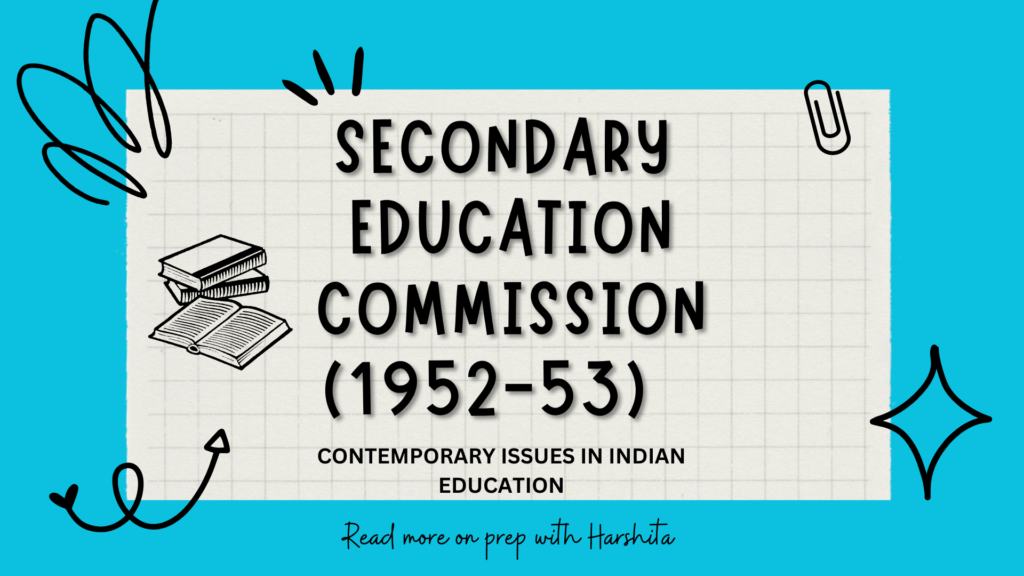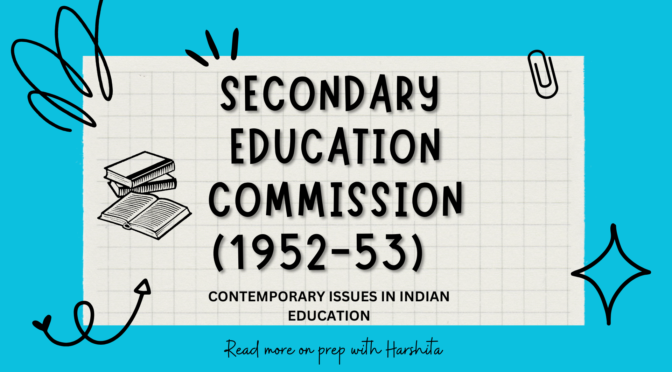The Secondary Education Commission, also known as the Mudaliar Commission, was established in India in 1952 to examine the state of secondary education and make recommendations for its development.
Here are more details about the Secondary Education Commission (1952-1953):
- Background: The commission was formed in response to the need for educational reforms in India after independence. It aimed to address the challenges faced by secondary education, which refers to the education provided after primary education and before higher education.
- Composition: The commission consisted of 24 members, including renowned educationists, administrators, and experts in the field of education. Dr. A. Lakshmanaswami Mudaliar, the Vice-Chancellor of Madras University, served as the chairman of the commission.
- Objectives: The commission had several objectives, including:
a. Assessing the state of secondary education in India, including its quality, access, and relevance.
b. Identifying the issues and challenges faced by secondary education.
c. Making recommendations to improve the quality and effectiveness of secondary education.
d. Examining the role of secondary education in social and economic development.
e. Advising on the organization, curriculum, examination system, and teacher training in secondary education. - Scope: The commission’s mandate covered the entire spectrum of secondary education, including both general education and vocational education. It examined different aspects such as curriculum, textbooks, examination systems, teacher training, infrastructure, and the role of secondary education in national development.
- Consultations and Research: The commission conducted extensive consultations with various stakeholders, including educators, administrators, and experts. It also conducted surveys, collected data, and reviewed existing educational policies and practices.
- Report: The commission submitted its report, titled “Secondary Education and Social Development,” in 1953. The report was comprehensive, analyzing the state of secondary education in India and providing recommendations for its improvement.
- Key Recommendations: Some of the major recommendations of the Mudaliar Commission included:
a. Expansion and Access: The commission emphasized the need to expand secondary education and make it accessible to a larger number of students, particularly in rural areas. It called for an increase in the number of secondary schools and the removal of barriers to enrollment.
b. Curriculum Reforms: The commission recommended a balanced and comprehensive curriculum that integrated academic subjects, vocational education, and practical skills. It suggested a flexible curriculum that allowed students to choose subjects based on their interests and aptitudes.
c. Examination System: The commission advocated for reforms in the examination system to make it more relevant, less burdensome, and focused on assessing conceptual understanding and practical skills. It recommended a shift from rote memorization to a more comprehensive evaluation approach.
d. Teacher Training: The commission stressed the importance of quality teacher training programs to improve the competence and professionalism of secondary school teachers. It recommended the establishment of teacher training institutions and the provision of in-service training opportunities.
e. Vocational Education: Recognizing the importance of vocational education, the commission recommended the integration of vocational subjects into the secondary education system. It emphasized the need to provide practical skills and vocational guidance to students to enhance their employability.
f. Infrastructure and Resources: The commission highlighted the need for adequate infrastructure, learning resources, and libraries in secondary schools. It recommended the provision of well-equipped laboratories, libraries, and classrooms to create a conducive learning environment. - Impact: The recommendations of the Mudaliar Commission had a significant impact on subsequent educational policies and reforms in India. They influenced the development of secondary education by guiding government initiatives and shaping the curriculum, examination systems, and teacher training programs.
The Secondary Education Commission (1952-1953) played a crucial role in shaping the direction of secondary education in India. Its in-depth analysis and recommendations provided a roadmap for the development of secondary education, focusing on access, quality, relevance, and the integration of vocational education.
Also Visit: Prep with Harshita

Also Read: Common School System


You can email the site owner to let them know you were blocked. Please include what you were doing when this page came up and the Cloudflare Ray ID found at the bottom of this page. Those revenues came from a sports betting handle of over $811.2 million, which grew from over $726.3 million in Sept. 2023. Most of last month’s handle came from online betting sites, with operators contributing more than $765.4 million. This was enough to beat the total sports betting handle from a year ago. You can email the site owner to let them know you were blocked. Please include what you were doing when this page came up and the Cloudflare Ray ID found at the bottom of this page. Parx is one of eight Pennsylvania casinos to offer sports betting, including at its sub-brands, the Turf Club and Valley Forge Turf Club, thus positioning the brand to become one of the state’s early online sports betting leaders.
https://oneeastcapital.co.uk/2025/05/27/ghanas-weekly-trends-in-aviator-game-traffic-a-deep-dive-into-sprs-popular-online-casino-game/
You are eligible for FREE COINS from us! You can play free online slots without downloading any software; check out our site to discover thousands of free slot machine games that may interest you. For many of these free online games, the playing format is straightforward: Keep an eye out for some of these features in some of your favorite free online slots. As slot manufacturers become more creative and continue to offer more interesting and dynamic games, more bonus features and games could be on the horizon as well. These will be a part of the free slot environment as well. If you choose to play free online slots, chances are you’ll do so because you’ll want to try real money casino games afterwards to win real money – if free online slots are to your liking, of course. When it comes to casino games, even free slots, it’s important to understand what you’re doing and what’s happening on your screen. There’s no risk in free play, but it’s never a disadvantage to actually understand what you’re doing – even if you’re just having fun.
Observați bine fiecare situație și definiți când este cel mai bine pentru dvs. să deveniți un cub de gheață alunecos și solid. Încercați să ajungeți la cutia pentru a fi trimis la nivelul următor. Este posibil să trebuiască să vă transformați în gheață pentru a aluneca pe pământ sau să dezghețați pentru a rămâne nemișcat. Interacționează cu restul obiectelor din fiecare nivel și încearcă să-ți elimini inamicii. Distrează-te jucând Icy Purple Head 3! Ca orice joc de cazino, Plinko Spribe are avantajele și dezavantajele sale. Ca orice joc de cazino, Plinko Spribe are avantajele și dezavantajele sale. Ca în cazul oricărui joc de cazino, Mines poate fi admirat sau pus la îndoială. Procesul de joc-ul, trebuie spus, este distractiv. Dacă vă place să alegeți un porc într-un poke, veți aprecia beneficiile acestui joc. De asemenea, ar fi incorect să păstrăm tăcerea asupra lucrurilor care nu sunt pe placul unor jucători.
https://abundantcaresolutions.com/review-de-ce-versiunea-mobila-a-lucky-jet-este-preferata-in-moldova/
Produse precum Creion mecanic de ochi Infaillible 36H Grip Bronze Blaze Soft Gold, 1ml, L’Oreal Paris RRP: 169.44RON Tease your sweet spots with the So Divine Get Lucky USB Vibrator. Explore tantalising pleasure with three speed settings and four pulsating patterns. Culoare: negru Supersoft este una dintre cele mai populare mingi de golf, în special pentru distanța lungă și dreaptă și, cel mai important, senzația super moale. Am avansat tehnologiile de acoperire, de bază și de construcție pentru a îmbunătăți aceste beneficii cheie, cu performanțe îmbunătățite de la tee la verde. The service will help you to attract the indexing robots of Google search engine (Googlebot) and get indexed your web page or backlinks faster BLACK SEO LINKS, BACKLINKS, SOFTWARE FOR MASS BACKLINKING — TELEGRAM @SEO_LINKK